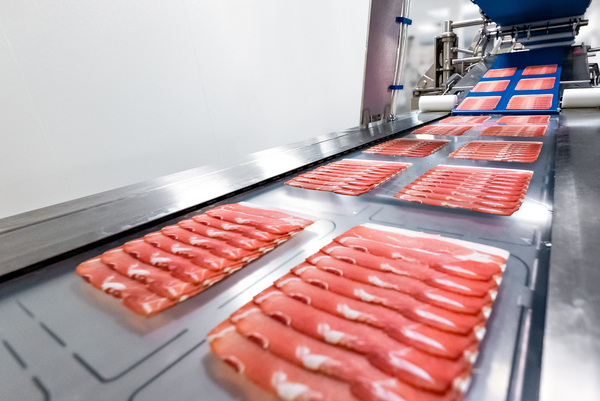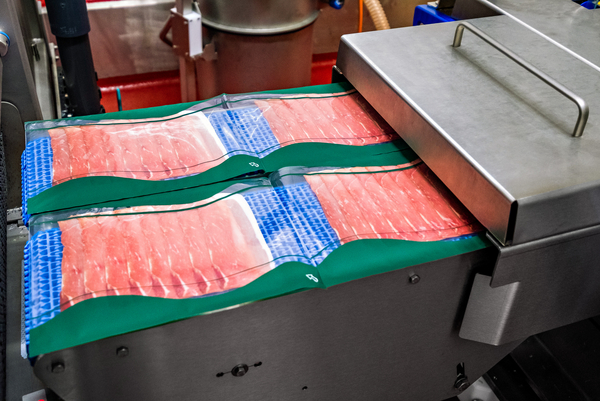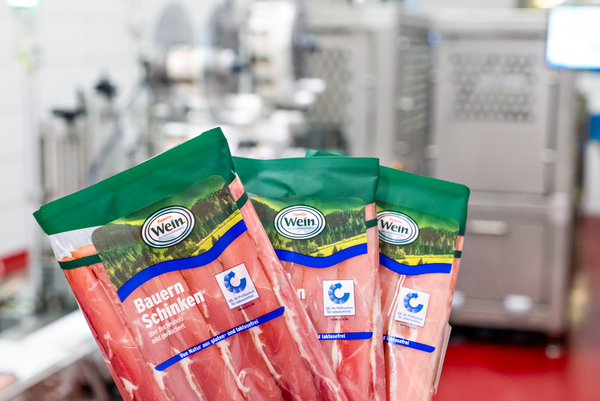The Genussmanufaktur Wein relies on a fully integrated line solution from Weber Food Technology.
Good ingredients, decades of experience, the proper secret recipe and craftsmanship is what makes the taste of a Black Forest ham. The use of fir wood, spruce twigs and juniper branches in the smoking process is considered a science in itself within the industry. The Genussmanufaktur Wein from the Black Forest region knows this all too well. Ham is a tradition at the Wein company. The family business has been producing three million hams annuallyfor more than 50 years. Their specialty is Black Forest ham - Schwarzwälder Schinken. It takes several week long production process until a Black Forest ham has matured and is ready to find its way into the packaging on a production line from Weber Food Technology.
Freshly sliced ham in folded packaging: for Genussmanufaktur Wein in the city of Freudenstadt, this packaging is a tangible contribution to a more sustainabe and resource conscious production. The packaging needed for ham in food retail uses two-thirds less plastic. In order to increase production capacities, the Wein Company has commissioned a fully automated production line by Weber Food Technology.
"We always see the greatest improvement in communication during the process." This statement comes from Andreas Hofer, Managing Director of Herrmann Wein GmbH & Co. KG from Freudenstadt. The family business is one of the leading producers of Black Forest ham. Their specialties can be found in almost any supermarket, discounter or food retailer throughout Europe. Production and process optimization is in high demand, as food producersoperate in a market where financial pressure is met with a high quality expectations. The Genussmanufaktur Wein focuses therefore on a clearly defined range of products with the goal of bundling investments in machinery and know-how most effectively. The family business has been producing ham specialties since 1966.
Processing raw ham efficiently and economically.
If you want efficient and economical ham processing, you use production lines that achieve maximum use of the product. Moreover, set-up times must be reduced to a minimum in order to preserve valuable production capacities. And at the end of the line, what counts is how much product ultimately ends up in the package. Every gram too much has a negative effect on the yield as a so-called give-away. These briefly outlined basic conditions have significant impact on the concept of modern production facilities. In addition, these systems should be as easy as possible to operate, since production lines typically run with a semi-skilled workforce. The line solutions from Weber Food Technology leave nothing to be desired for when it comes to process and network integration. To refer back to Andreas Hofer's earlier statement, the network is the measure of all things, which is why communication in the process is so important. "Together with Weber, we have found a smart solution. We trustthe system and are very much looking forward to developing them further alongside each other in the process."
From the perspective of the production process, the new slicing line, including packaging machine and downstream folding and labeling system, starts with the ham feed via an LED scanner. This unit measures the length and diameter of the raw ham. The product is fed to an LED camera system, which measures it one by one and then weighs it on a weighing station. The obtained data is used to determine the ideal weight of the individual ham slices via the surface area and slice thickness.
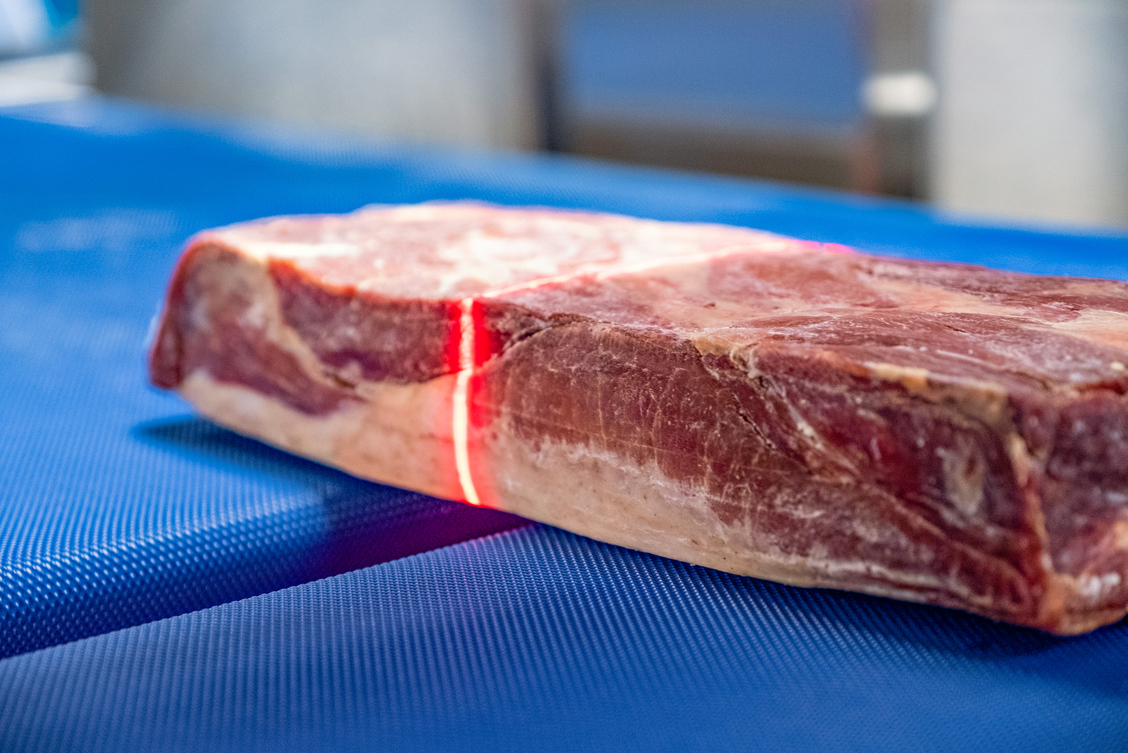
Hence, the scanner information is an important pilot signal for the following Weber Slicer 804 MCS. On average, each slice of raw ham weighs ten grams and is positioned in portions on the automatic feeder in shingled form. A typical 80-gram folded packaging therefore contains eight perfectly sliced slices. How thick the slicer cuts these slices depends on the scanner data and the calculations provided. There is also a second control loop set up through a dynamic checkweigher at the end of the line that feeds information back to the slicer.
Perfect integration of all Weber components.
"We place great importance onto excellent machine-to-machine communication", emphasizes Andreas Hofer. "When we have equalized the 80 grams of packed ham, the checkweigher communicates with the slicer. Both modules autocorrect as to slices of ham should be cut thicker or thinner." In doing so, the checkweigher determines an average value of the measured package weight, which represents a trend and is fed back to the slicer for correction. "With this system, we are extremely well positioned for the future," emphasizes the Managing Director - also with regard to high operating efficiency, thanks to the remote maintenance access (Weber Remote Service) and the BDE data evaluation (Weber@net). Service technicians from Weber can instantly intervene in case of a downtimeevent or carry out optimizations together with the Black Forest ham manufacturer. "This enables comprehensive process management for the future with the goal of sustainably improving all processes," explains Matthias Köster, Area Sales Manager at Weber. For Andreas Hofer, the expertise and personality of the technicians alsotipped the scale in favor of Weber. "They offer the total package from top to bottom."
For the Managing Director, the tight-knit connection to Weber Food Technology is also part of a company philosophy that evolved over time, because it enables his company to free resources that are limited. "In 2008, we started with folded packaging, which we hand folded in the beginning," says his sister and partner Anja Hofer-Kohrs, as she looks back.
After twelve years of experience, the time had come "for fully automatic folding packaging from a single source". The Genussmanufaktur Wein specifically opted for a complete line from Weber because the individual components, such as the slicer and the packaging machine, are perfectly integrated, feed information to each other, so parameters are automatically adjusted when necessary. In Freudenstadt, the decision to use folded packaging is part of an overall effort for more sustainable production . With a film thickness of between 50 and 60 µ, this material weighs in only at one fifth of the surface weight of hard-shell packaging. The latter often uses 300 µ thick bottom films.
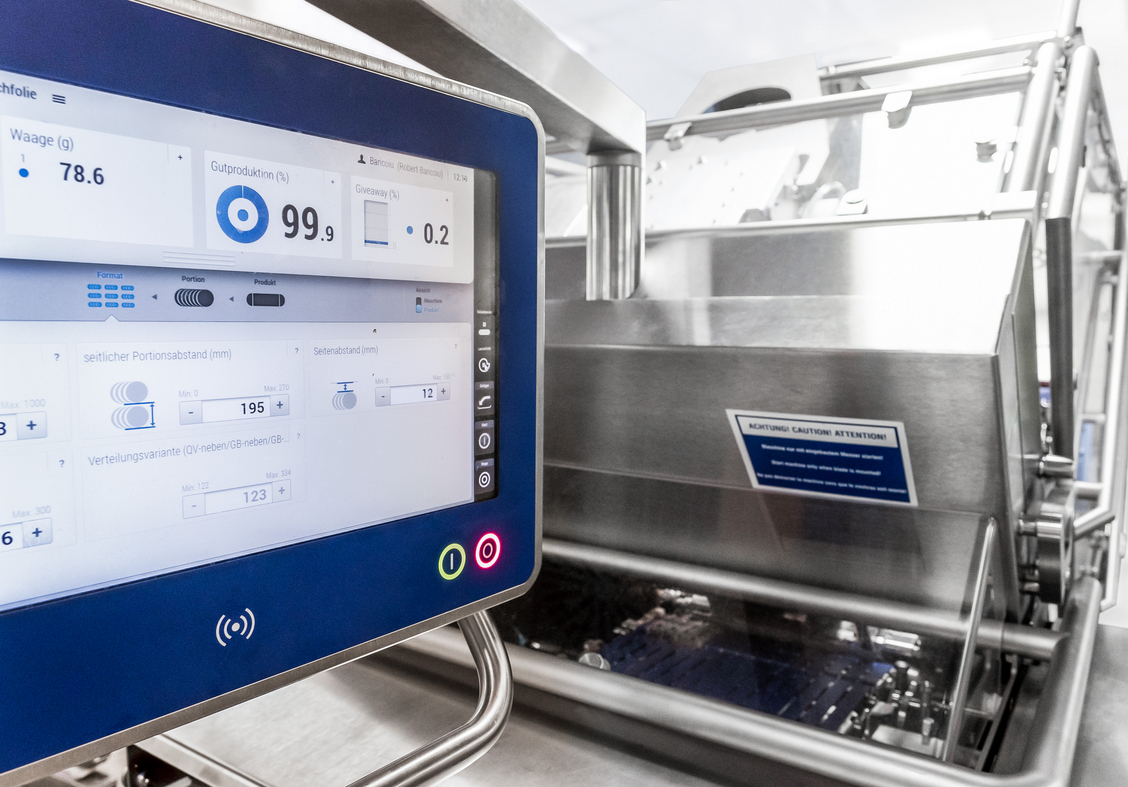
Resource-saving packaging solution for raw ham.
Especially for the Black Forest region, it is remarkable to see how open the company is about this resource-saving packaging solution for raw ham. "When we can save resources through new machine technology, it benefits all of society. We don't want to differentiate ourselves from the competition by using resources that belong to the community," Anja Hofer-Kohrs sums it up. Following this statement, her brother sees no need to reconcile to what extent the innovations created between Wein and Weber benefit the entire industry. "We want to differentiate ourselves through our products. Currently, competition advantage is all about price and resource conservation. The right way to go about it, is to ask yourself how you can make your own product better.”
Within this objective, the new Weber system offers a smart solution for inserting raw ham into packaging with minimal product loss. "Trim, even if we process it into ham cubes and strips later on, is of no use to anyone. Pigs have been raised for this purpose and environmental consequences have beenwidely accepted. That's why we have to smarter when it comes to trim and packaging." With this in mind, Weber Food Technology does not supply off-the-shelf lines, but they vigorously analyse the specific process and, above all, the special features of a product with the customer in the run-up. In Andreas Hofer's experience, there are numerous mechanical engineering companies with good approaches. "But when it comes to support and long-term implementation, they don't deliver. We don't want to start from scratch every time because they keep bringing in new technicians. That is where Weber is different. Their workforce management is excellent. And even when the desired outcome is not achieved immediately, they stay on the job.”
Safe packaging process thanks to high positioning accuracy.
Based on extensive customer needs analysis, Weber developed the innovative portion control, which the Wein company also relies on. "Our goal is to ensure that the perfectly sliced portion lies perfectly in its packaging," says Matthias Köster about how the process works.. Positional accuracy makes the packaging process safer because the product maintains a sufficient distance from the sealing seam. In addition, the correctly positioned product no longer has to be aligned manually by an employee. This seemingly small detail saves labor on the one hand and also increases hygiene on the other, as the ham is no longer manually handeled after slicing. The fundamentals of portion control and correction are also the close data exchange of all line components. Consistency is best achieved when the entire system is designed by a single source. With this in mind, Weber has integrated a conveyor belt labeling system in addition to the folding line from sb-pack. These components offer the advantage that they are versatile and can be used on other production lines.
Despite the fact that the functional integration of a compact production line is very extensive and concerns very different processes, the operation is simple. The production employees have the ability to control all processes of the individual components from any touch panel on the line. In addition, the separation and rejection of empty packs is already integrated into the folding system. This detail ensures that further end-of-line devices can be omittedwhich reduces line footprint complexity.
Hygiene is increasingly playing a vital role in the design of food processing equipment. The focus on hygienic design is on how systems can be cleaned as safely and, above all, as efficiently as possible. Every four hours, the equipment at the Genussmanufaktur Wein is cleaned and disinfected. "The new slicers from Weber have an open design, which makes the work much easier," Andreas Hofer reports. In addition, many components that come into contact with the product are designed as interchangeable assemblies. While one assembly is being cleaned, production can continue with another. "With our older machines, a special company comes, disassembles everything, cleans everything and then reassembles the whole thing." This results in downtimes during which production cannot take place. When it comes to hygienic design, mechanical engineering companies have to understand the processes and also the demands of food processors in order to build the machines correctly with regard to hygiene. "Here, too, trust in Weber has grown over the years, which is why we will continue to rely on their solutions in the future," Hofer concludes.
We are looking forward to your message.

Kansas City MO 64153


